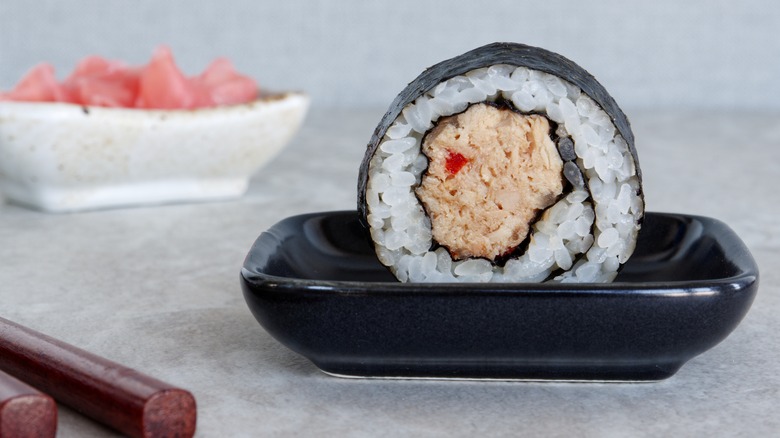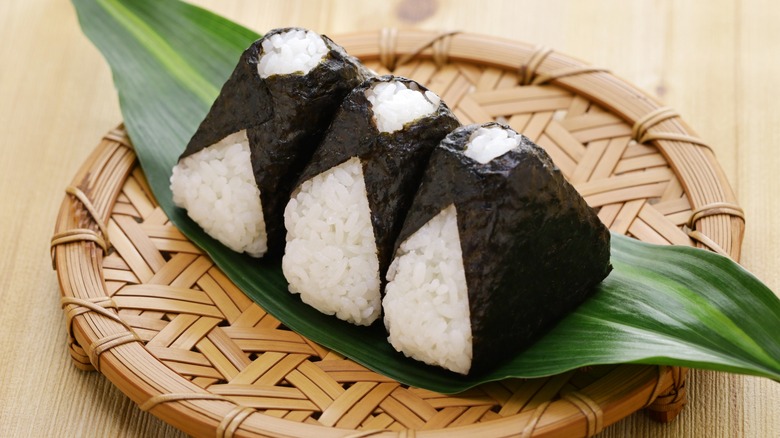Use Canned Tuna To Save Money On Your Next Homemade Sushi Night
Rolling your own homemade sushi can be immensely gratifying and more affordable than pulling up a stool at the bar of your local Japanese restaurant, but buying sushi-grade tuna for your nori-wrapped dinner can still be cost-prohibitive. Why not try using canned tuna, instead?
Sushi or sashimi-grade fish is carefully handled and packaged to minimize the chances of contamination, so that it may be safely consumed raw. High-quality, healthy fish are caught, cleaned, and flash frozen the same day to ensure freshness. These precautionary safety measures incur a high price, with sushi-grade tuna coming in at anywhere from $27 on the low end (for yellowfin) to nearly $100 (for lean bluefin) per pound. And forget pricier cuts of the fish from the belly, which might run you double. On the other hand, canned tuna is available for as little as $1.98 per 5-ounce can, though if you shop around, you can opt for the very best brands, and it will set you back approximately $7 per 3.5-ounce can. Either way, even buying the tastiest and most expensive can of tuna will likely be more affordable than choosing fresh.
Canned tuna sushi is enjoyed in Japan
Purists who revere high-end omakase dining may scoff at the idea of using canned tuna for sushi, but incorporating cooked seafood into the dish has been a commonplace practice in Japan since the 1960s. Ippei Sushi, a restaurant in Miyazaki, Japan, claims to be the first to try an alternate filling for makizushi (sushi rolls) by mixing cooked shrimp with mayonnaise and wrapping it in nori alongside fresh, rolled lettuce over half a century ago.
In a similar vein, one of the most talked about, easy meals in Japanese cuisine is onigiri, balls of sticky sushi rice stuffed with canned tuna and mayonnaise salad that are wrapped in crisp sheets of seaweed. These popular, cleverly packaged cellophane-wrapped bundles are typically eaten for breakfast or lunch and are often sold at more-than-reasonable prices in convenience stores called konbinis, many of which are open 24/7. Creating makizushi with the same fillings only changes its form, securing it inside a roll and slicing it into bite-sized morsels.
Canned tuna sushi is all about the seasonings
While the flavor of canned tuna packed in oil or water has a rich, unctuous flavor all its own, you may want to add some extra oomph when seasoning it for sushi. Flake or shred the tuna to the consistency you prefer and mix it with a few tablespoons of mayo, preferably Japanese Kewpie mayo, which uses extra egg yolk, resulting in a rich, umami flavor. However, if you're unable to find the cult-favorite brand, using what you have in the fridge is fine — though making our easy homemade mayonnaise is even better.
Apart from the tuna and mayo, you can add sesame seeds and a drizzle of sesame oil to add a nutty note to your sushi, or if you like it hot, add a few drops of chile oil or a pinch of shichimi togarashi (a Japanese chile pepper-based seasoning blend)and a spoonful of crispy fried garlic. Makizushi can also benefit from a contrasting texture, so be sure to roll in a cucumber spear, lettuce, matchstick slices of carrot or even pickled daikon. Then all you have to do is serve your canned tuna salad makizushi with wasabi, ginger, and soy sauce and you're good to go.


